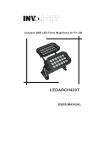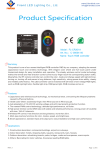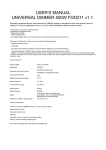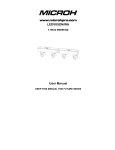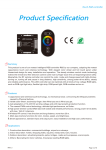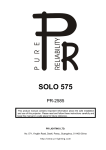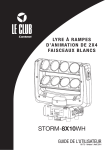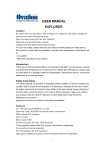Download USER MANUAL
Transcript
CROSS 280 Caution ! Be careful with your operations. With a dangerous voltage you can suffer a dangerous electric shock when touching the wires! Keep this device away from rain and moisture! Make sure it is grounded when using it! Unplug mains lead before opening the housing! For your own safety, please read this user manual carefully before you initial start-up. Every person involved with the installation, operation and maintenance of this device has to - be qualified - follow the instructions of this manual Introduction Thank you for having chosen CROSS 280 . You will see you acquired a powerful and versatile device. Unpack your item. Before you initial start-up, please make sure that there is no damage caused by transportation. Should there be any, consult your dealer and do not use the device. Safety instructions This device has left our premises in absolutely perfect condition. In order to maintain this condition and to ensure a safe operation, it is absolutely necessary for the user to follow the safety instructions and warning notes written in this user manual. Always disconnect from the mains, when the device is not in use or before cleaning it. Keep away children and amateurs from the device! There are no serviceable parts inside the device. Maintenance and service operations are only to be carried out by authorized dealers. Installation On the rear panel of the item you can find an 3pin XLR-jack (DMX Out) and an 3pin XLR-plug (DMX In), which can be used for connecting several devices. Choose the device which is to control the effects. Connect the DMX OUT-jack with the DMX IN-plug of the next device. 1 DMX-512 connection / connection between fixtures Occupation of the XLR-connection: If you are using controllers with this occupation, you can connect the DMX-output of the controller directly with the DMX-input of the first fixture in the DMX-chain. If you wish to connect DMX-controllers with other XLR-outputs, you need to use adapter-cables. Building a serial DMX-chain: Connect the DMX-output of the first fixture in the DMX-chain with the DMX-input of the next fixture. Always connect one output with the input of the next fixture until all fixtures are connected. DMX-512 connection with DMX terminator For installations where the DMX cable has to run a long distance or is in an electrically noisy environment, such as in a discotheque, it is recommended to use a DMX terminator. This helps in preventing corruption of the digital control signal by electrical noise. The DMX terminator is simply an XLR plug with a 120 resistor connected between pins 2 and 3,which is then plugged into the output XLR socket of the last fixture in the chain. Please see illustrations below. Caution: At the last fixture, the DMX-cable has to be terminated with a terminator. Solder a 120 resistor between Signal (–) and Signal (+) into a 3-pin XLR-plug and plug it in the DMX-output of the last fixture. Connection with the mains Connect the device to the mains with the enclosed power supply cable. Control menu map 2 Operation Projector DMX starting address selection All fixtures should be given a DMX starting address when using a DMX signal,so that the correct fixture responds to the correct control signals. This digital starting address is the channel number from which the fixture starts to listen to the digital control information sent out from the DMX controller. The allocation of this starting address is achieved by setting the correct number on the display located on the base of the device. 3 You can set the same starting address for all fixtures or a group of fixtures, or make different address for each fixture individually. If you set the same address, all the units will start to listen to the same control signal from the same channel number. In other words, changing the settings of one channel will affect all the fixtures simultaneously. If you set a different address, each unit will start to listen to the channel number you have set, based on the quantity of control channels of the unit. That means changing the settings of one channel will affect only the selected fixture. In the case of this fixture, which is 10/36 channels. When you select the standard channel mode, you should set the starting address of the first unit to 1, the second unit to 11/37(10+1/36+1), the third unit to 21/47(10+11/10=37), and so on. Control Board The Control Board offers several features: you can simply set the starting address, run the pre-programmed program or make a reset. The main menu is accessed by pressing the Mode-button until the display starts flashing. Browse through the menu by pressing the Up-button or Down-button. Press the Enter-button in order to select the desired menu. You can change the selection by pressing the Up-button or Down-button. Confirm every selection by pressing the Enter-button.You can leave every mode by pressing the Mode-button.The functions provided are described in the following sections. OVATION CROSS 280 Channel DMX Table 23 Channel mode Function CH1 Pan CH2 Pan Fine CH3 Tilt CH4 Tilt Fine CH5 Pan/Tilt Speed CH6 Macro Function Function Control 0-255: Pan 0°-540° 0-255: Tilt 0°-270° 0-19: No function 20-24: Energy Saving Mode ( 230w ) 25-129: No function 130-139 : Light on 140-149: Pan , Tilt reset 150-159: No function 4 160-169: All motor reset 170-199: No function 200-209: Reset 210-229: No function 230-239: Light off 240-255: No function CH7 Color Wheel CH8 Color Wheel Fine 0-8: White 9-17: White+Fluorescent Blue 18-26: Fluorescent Blue+Cooling 27-35: Cooling + Orange 36-4: Orange + Blue 45-53: Blue+Amber 54-62: Amber+Dark Green 63-71: Dark green +Red 72-80: Red+Sky Blue 81-89: Sky Blue+Magenta 90-98: Magenta+Green 99-107: Green+Yellow 108-116: Yellow+Deongaree 117-127: Deongaree+Crimson 128-129: Crimson+White 130-134: Crimson 135-138: Deongaree 139+143: Yellow 144-147: Green 148+152: Magenta 153-157: Sky Blue 158-161: Red 162-166: Dark Green 167-171: Amber 172-176: Blue 177-180: Orange 181-185: Cooling 186-189: Fluorescent Blue 190-220: From fast to slow flow 221-250: From slow to fast flow 251-255: Random variation by voice CH9 CH10 Gobo Wheel 0-87: Fixed Pattern 0-3: No Function 4-9:Pattern 1 10-15: Pattern 2 5 16-21: Pattern 3 22-27: Pattern 4 28-33: Pattern 5 34-39: Pattern 6 40-45: Pattern 7 46-51: Pattern 8 52-57: Pattern 9 58-63: Pattern 10 64-69: Small Beam 1 70-75: Small Beam 2 76-87: Small Beam 3 88-199: Pattern shake from slow to fast 88-95: Pattern 1 96-103: Pattern 2 104-111: Pattern 3 112-119: Pattern 4 120-127: Pattern 5 128-135: Pattern 6 136-143: Pattern 7 144-151: Pattern 8 152-159: Pattern 9 160-167: Pattern 10 168-175: Small Beam 1 176-183: Small Beam 2 184-199: Small Beam 3 200-255: The fixed pattern flowing from slow to fast CH11 Gobo Wheel 0-89: Rotation Pattern 0-8: No Function 9-17:Pattern 1 18-26: Pattern 2 27-35: Pattern 3 36-44: Pattern 4 45-53: Pattern 5 54-62: Pattern 6 63-71: Pattern 7 72-80: Pattern 8 81-89: Pattern 9 90-255: Pattern shake from slow to fast 90-97: Pattern 1 98-106: Pattern 2 107-115: Pattern 3 116-124: Pattern 4 125-133: Pattern 5 6 134-142: Pattern 6 143-151: Pattern 7 152-160: Pattern 8 161-169: Pattern 9 171-179: Pattern 9 not moving 180-217: From fast to slow flow 218-255: From slow to fast flow CH12 Pattern Rotation 0-127: Pattern Change 128-177: Anti-Clockwise from slow to fast flowing 178-203: Stop 204-255: Clockwise from slow to fast flowing CH13 CH14 Prism 0-19: No function 20-75: Six linear prism 76-255: Eight side circular prism 0-127: Prism Change 128-191: Clockwise from fast to slow flowing 192-193: No function 194-255: Anti-Clockwise from slow to fast flowing CH15 Prism Rotation CH16 Frost 0-64: No function 65-255: 100% Linear Frost CH17 Zoom 0-255: 0-100% Linear Zoom CH18 Zoom Fine CH19 Focus CH20 Zoom Fine 0-255: Zoom Fine 0-255: Zoom Fine CH21 CH22 Strobe CH23 Dimmer 0-31:Strobe Off 32-63: Strobe On 64-95:Strobe from slow to fast 96-127: Strobe On 128-143: From fast to slow ( slow close , quick open ) 144-159: From slow to fast ( quick open , slow close ) 160-191: Strobe On 192-223: Random strobe from slow to fast 224-255: Strobe On 0-255: 0-100% linear dimmering 7 16 Channel mode Function CH1 Pan 0-255: Pan 0°-540° CH2 Tilt 0-255: Tilt 0°-270° CH3 Pan/Tilt Speed CH4 CH5 Macro Function Color Wheel Function Control 0-19: No function 20-24: Energy Saving Mode ( 230w ) 25-129: No function 130-139 : Light on 140-149: Pan , Tilt reset 150-159: No function 160-169: All motor reset 170-199: No function 200-209: Reset 210-229: No function 230-239: Light off 240-255: No function 0-8: White 9-17: White+Fluorescent Blue 18-26: Fluorescent Blue+Cooling 27-35: Cooling + Orange 36-4: Orange + Blue 45-53: Blue+Amber 54-62: Amber+Dark Green 63-71: Dark green +Red 72-80: Red+Sky Blue 81-89: Sky Blue+Magenta 90-98: Magenta+Green 99-107: Green+Yellow 108-116: Yellow+Deongaree 117-127: Deongaree+Crimson 128-129: Crimson+White 130-134: Crimson 135-138: Deongaree 139+143: Yellow 144-147: Green 148+152: Magenta 153-157: Sky Blue 158-161: Red 162-166: Dark Green 167-171: Amber 172-176: Blue 8 177-180: Orange 181-185: Cooling 186-189: Fluorescent Blue 190-220: From fast to slow flow 221-250: From slow to fast flow 251-255: Random variation by voice CH6 CH7 CH8 Gobo Wheel 0-87: Fixed Pattern 0-3: No Function 4-9:Pattern 1 10-15: Pattern 2 16-21: Pattern 3 22-27: Pattern 4 28-33: Pattern 5 34-39: Pattern 6 40-45: Pattern 7 46-51: Pattern 8 52-57: Pattern 9 58-63: Pattern 10 64-69: Small Beam 1 70-75: Small Beam 2 76-87: Small Beam 3 88-199: Pattern shake from slow to fast 88-95: Pattern 1 96-103: Pattern 2 104-111: Pattern 3 112-119: Pattern 4 120-127: Pattern 5 128-135: Pattern 6 136-143: Pattern 7 144-151: Pattern 8 152-159: Pattern 9 160-167: Pattern 10 168-175: Small Beam 1 176-183: Small Beam 2 184-199: Small Beam 3 200-255: The fixed pattern flowing from slow to fast Gobo Wheel 0-89: Rotation Pattern 0-8: No Function 9-17:Pattern 1 18-26: Pattern 2 27-35: Pattern 3 36-44: Pattern 4 9 45-53: Pattern 5 54-62: Pattern 6 63-71: Pattern 7 72-80: Pattern 8 81-89: Pattern 9 90-255: Pattern shake from slow to fast 90-97: Pattern 1 98-106: Pattern 2 107-115: Pattern 3 116-124: Pattern 4 125-133: Pattern 5 134-142: Pattern 6 143-151: Pattern 7 152-160: Pattern 8 161-169: Pattern 9 171-179: Pattern 9 not moving 180-217: From fast to slow flow 218-255: From slow to fast flow CH9 CH10 Pattern Rotation Prism 0-127: Pattern Change 128-177: Anti-Clockwise from slow to fast flowing 178-203: Stop 204-255: Clockwise from slow to fast flowing 0-19: No function 20-75: Six linear prism 76-255: Eight side circular prism 0-127: Prism Change 128-191: Clockwise from fast to slow flowing 192-193: No function 194-255: Anti-Clockwise from slow to fast flowing CH11 Prism Rotation CH12 Frost 0-64: No function 65-255: 100% Linear Frost CH13 Zoom 0-255: 0-100% Linear Zoom CH14 Focus CH15 Strobe 0-31:Strobe Off 32-63: Strobe On 64-95:Strobe from slow to fast 96-127: Strobe On 128-143: From fast to slow ( slow close , quick open ) 144-159: From slow to fast ( quick open , slow close ) 10 160-191: Strobe On 192-223: Random strobe from slow to fast 224-255: Strobe On CH16 Dimmer 0-255:0-100% linear dimming Set DMX address Display the DMX 512 value of each channel.With this function you can display the DMX 512 value of each channel. The display automatically shows the channel with a value changing. Synchronization & master /slave mode Take some items and connect them by DMX cables, disconnect the items from DMX controller, the items will wok synchronously, one as master, the others as slave. Auto Program With this function, you can run the internal program. You can select the desired program under.You can set the number of steps under .You can edit the individual scenes under .With this function, you can run the individual scenes either automatically, i.e. with the adjusted Step-Time. Specifications Physical Length: 385 mm Width: 365 mm Height: 589 mm Weight: 17.5kg without accessories Dynamic effects Lamp:SIRIUS HRI 280W Color Wheel :13+open Gobo Wheel : Gobo Wheel 1: 14+open Gobo Wheel 2: 9+open 11 Beam color temperature: CTO, 9300K Beam color temperature: CTO, 9300K Electronic dimming: 0-100% linear dimming Strobe and pulse effects: 1-15 times/second, flicker free Speed color-wheel: rotation effect and random color Electronic "shutter" effect: instant open and blackout Tilt1 : 0-540° Tilt2 : 0-270° Control and Programming Control option modes: DMX, stand alone , DMX channels: 16/23CH Addressing and setting: control panel with LCD display Control: DMX 512 Optics Light source: SIRIUS HRI 280W Minimum LAMP lifetime: 5000 hours Manufacturer’s figure obtained under manufacturer’s test conditions Construction Housing: High-impact, flammable- retardant, excellent Color: black IP rate: IP20 Installation Mounting: Adjustment bracket, surface or truss mount Orientation: Any Location: Outdoor/indoor use Connections Electrical DMX data in / through: 3-pin XLR and 5-pin XLR AC power in/through: 110-240v nominal, 50/60 Hz Rated power: 280w Thermal Cooling System: Forced air (temperature-regulated, low noise) Temperature: Max ambient 8 degree Included items Power cable 1.5m (4.9 ) Mounting bracket Remark: All information is subject to change without prior notice. 12












